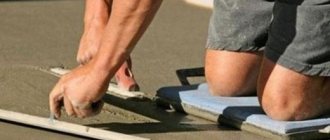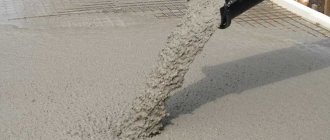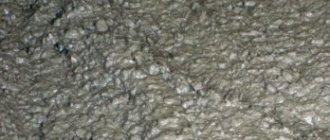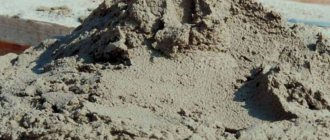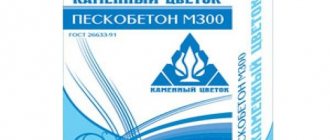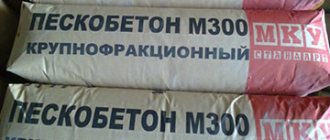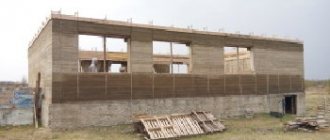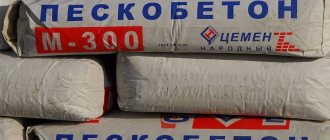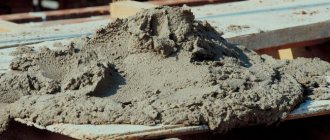Before planning a repair, to find out the consumption of M 300 sand concrete per 1 m2, use a calculation calculator. In this case, such parameters as the thickness of the applied solution and the amount of dry material are taken into account. What is the consumption of sand concrete per 1 square meter? On average, the rate of use of dry mixture per 1 m2 is 19-20 kg, and per cubic meter. should not be more than 750 kg.
The most popular brands of sand concrete M 300:
- "Dobromes";
- "Broseks" (BROZEX);
- "Ivsil"
Plastering walls
The ready-made mixture must be thrown onto the walls using a special ladle or trowel.
After this, a rule is taken and placed between two beacons so that the solution can be stretched from bottom to top. If there are a lot of problem areas and you need to use a large amount of mortar to mask the flaw, do not add a lot of mixture at once, since such plaster will crack very quickly and crumble. It is best to apply a layer of plaster to the problem areas, let it dry and only then apply the mixture again. If necessary, you can use a special mesh that will secure the solution.
Number of PCB bags for brickwork and calculations on a calculator
Laying a brick wall should be done using a mixture with a grade corresponding to the brick. This structure is as durable and uniform as possible. In general, M100-M200 is used for masonry.
So it is necessary to take into account the quality and strength of the material (both the mixture and the brick). Using basic standards, approximately 250 kg of M100 mixture should be used per 1 m3 of wall.
If you prepare the solution yourself, then the proportion should be 1 to 4. Liquid should be added to the CPS, which is usually half the total weight of the mixture.
Of course, the laying of a wall greatly depends on the thickness of the seams; as the space between the bricks expands, the amount of mortar per 1 m3 also increases. The thickness of the walls also plays an important role, so for facing bricks laid in 1 layer, significantly less cement is required than for load-bearing walls of 2-4 bricks.
Calculation for masonry
Regulatory documents contain detailed recommendations and the relationship between wall thickness and the amount of mortar used.
Examples are presented based on ordinary bricks and the required quantity per 1 m3:
- wall 12cm - 420 bricks and 0.19 m3 of mortar;
- wall 25cm – 400 bricks and 0.22 m3 of mortar;
- wall 38cm – 395 bricks and 0.234 m3 of mortar;
- wall 51cm – 394 bricks and 0.24 m3 of mortar;
- wall 64cm - 392 bricks and 0.245 m3 of mortar.
Pouring concrete
It is recommended to use the cement mortar within 2 hours after mixing. The raw material hardens quickly. After this time, it cannot be used. It is not advisable to add water and dilute the solution. It will not be possible to maintain exact proportions. The result will be low-quality building material. Possible destruction of the base structure. Reinforcement is required.
Pouring The concrete screed will dry in 24 hours. On the second day, they begin to dismantle the wooden formwork. A technical break is taken for a month. The foundation must gain strength, then you will get a high-quality concrete foundation. Otherwise, the consequences will be irreparable.
Preparation of concrete mixture by hand
For work you need two buckets and a pair of shovels. One of the buckets and one of the shovels are for cement only and must be completely dry. The second pair of tools is used for sand and gravel. Materials measured in buckets are lightly compacted with a shovel and leveled on top. To mix concrete, use a wide container. Sand and crushed stone are thoroughly mixed, creating grooves on the surface into which cement is poured. All components are mixed as many times as necessary to form a mass of uniform color.
The mixture is shaped into a cone, a hole is made in it and water is poured in. The composition is poured from the edges of the cone into a recess with water, it should be completely saturated. Then a cone is formed from the mass again and the previous steps are repeated until the concrete dough acquires the required consistency.
During the mixing process, water must be added in small portions; too much liquid will reduce all efforts to zero.
Compliance with the proportions will allow you to obtain a concrete mixture of the desired plasticity, homogeneity, and the absence of voids. This means that the structure has an impressive service life.
Expanded clay gravel has become widespread in construction due to the reliability of structures formed from it. Building forms and structures can last for decades without loss of physical and aesthetic characteristics. The composition of cement mortar and expanded clay belongs to the light group of concretes. The composition of expanded clay concrete contains coarse expanded clay aggregate, fine sand aggregate and cement as a binding component. In addition to cement, construction gypsum can be used for binding. Let us consider in detail what expanded clay concrete is, the proportions for mixtures of different densities, the scope and characteristics of the building material.
The choice between standards and the old-fashioned method
The existing rules are quite clear. However, according to them, the size of the cement powder actually used can be calculated only if you know not only its volumetric content, but also its characteristics:
- factional affiliation;
- purity;
- humidity level;
- density;
- how high-quality the products are from the chosen manufacturer, etc.
When considering standard indicators for the consumption of materials, it is worth taking into account the conditions in which it will be used. According to the current SNiP, we are talking about kneading at a temperature of 23 degrees Celsius and a humidity not exceeding 7%. In this case, the purchased cement composition must be fresh and exceed the consumption rates by 10-15%, because During storage, the density that the packaged Portland cement initially possesses is lost.
Composition of 1 cube of concrete
The preparation of a working solution based on brand strength, filler size and water-cement number is presented in the table.
| Concrete, M | Cement M | Ratio of water and cement, VC | Filler fraction, mm | Volume of water, l per m³ of concrete | Weight of cement, kg per m³ of concrete | Weight of sand, kg per m³ of concrete | Weight of crushed stone or gravel kg per m³ of concrete |
| ̴100 | ̴300 | 0.750 | 10.0 mm gravel | 205.00 | 273.00 | 1092.0 | 1092.0 |
| 0.80 | 10.0 mm crushed stone | 220.0 | 275.0 | 1100.0 | 1100.0 | ||
| 0.750 | 20.0 mm gravel | 190.0 | 253.0 | 1012.0 | 1012.0 | ||
| 0.80 | 20.0 mm crushed stone | 205.0 | 256.0 | 1024.0 | 1024.0 | ||
| 200 | 400 | 0.630 | 10 mm gravel | 205.00 | 325.0 | 1300.0 | 1300.0 |
| 0.680 | 10 mm crushed stone | 220.0 | 324.0 | 1296.0 | 1296.0 | ||
| 0.630 | 20.0 mm gravel | 190.0 | 302.0 | 1208.0 | 1208.0 | ||
| 0.680 | 20.0 mm crushed stone | 205.0 | 302.0 | 1208.0 | 1208.0 | ||
| 250 | 500 | 0.640 | 10.00 mm gravel | 205.0 | 320.0 | 1280.0 | 1280.0 |
| 0.690 | 10.00 mm crushed stone | 220.0 | 319.0 | 1276.0 | 1276.0 | ||
| 0.640 | 20.00 mm gravel | 190.0 | 297.0 | 1188.0 | 1188.0 | ||
| 0.69 | 20.00 mm crushed stone | 205.0 | 297.0 | 1188.0 | 1188.0 |
All components are connected in accordance with the selected proportion. The table shows how many kg of cement are in m³ of concrete.
Pricing depends on the season of work, which should be taken into account during the preparatory stage of construction
Specific gravity
When calculating the consumption of mortar, it is important to take into account the specific gravity of several types of sand concrete 1 m3:
- M 100 and M 150 are the lightest samples;
- M 300 is the most popular medium-weight mixture;
- M 400 and M 500 are the heaviest sand concrete samples.
The weight of sand concrete per 1m3 is indicated in the table below.
How to find out the amount of factory-prepared sand concrete
Sand concrete in packages
In developed countries, sand concrete has been used for many decades; in our country it appeared relatively recently. Some individual developers do not yet know what this material is and how to use it. Ignorance of the properties of the material does not allow us to calculate its approximate amount required for floor screed.
Sand concrete M300
Ordinary sand concrete is a mixture of sand of various fractions with cement in certain proportions. Special brands may have additional additives (plasticizers, modifiers, etc.) to obtain additional characteristics of the hardened mixture. This means that calculating the amount of sand concrete is no different from calculating a mixture prepared on your own. Unless, of course, price doesn’t matter to developers. Factory-made sand concrete will cost at least twice as much as home-made sand concrete. Why is this material so expensive? There are several reasons.
- Sand for preparing sand concrete must be sifted using special equipment to separate it into fractions.
- To ensure that the cement does not lose its qualities, the sand should be dried. These are large additional energy costs.
- The line for mixing ingredients and filling is quite expensive.
- For storage you need to use sealed bags that do not allow moisture to pass through.
To all this are added the inevitable storage losses, a markup on the profitability of the manufacturing company, and the total result is a high cost.
For floor screeding, it is recommended to use sand concrete grade M300; the quantity can only be determined approximately using the algorithm described above.
Required material consumption for semi-dry floor screed
Floor screed consumption per 1 square meter of material, as a rule, must be calculated using specialized construction equipment.
The process of preparing a cement-sand mixture for a semi-dry screed requires precise adherence to the proportions of all necessary components. To make the solution you need:
- Cement. It is recommended to use Portland cement M500 d0 or M500 D20
- Washed or sifted coarse sand without large inclusions and various kinds of residues. It is advisable to use sand with a fraction of 2.5-3mm.
- Water. It is not recommended to take from unverified sources due to possible contamination with household waste and small natural particles. The ideal option is non-chlorinated from a well.
- Fiber fiber. The approximate calculation is 40 grams per 1 square meter of solution with a thickness of 50 mm.
- Initially, cement and sand are mixed together in a proportion of 1/4.5 to 1/6 (depending on the requirement for brand strength), after which water with fiber fiber is added to the dry mixture in portions.
How to calculate material consumption for a semi-dry floor screed
The calculation of floor screed, cement, sand and fiberglass for a semi-dry screed is carried out in the following way:
- For 1 square meter with a thickness of 50 mm, we use on average 15 kg of cement, 0.065 m3 of coarse sand, 2-3 liters of water and 35-40 grams of fiberglass.
- Accordingly, if you have an object with an area of 100 m2, then to install a semi-dry screed 5 cm thick you will need 100 * 15 = 1500 kg of cement (30 bags of 50 kg each), 0.065 * 100 = 6.5 m3 of sand, 35 * 100 = 3500 g or 3.5 kg of fiberglass. It’s also worth taking into account the cost of plastic film and damper tape.
In this way you can protect any volume at any thickness and, as practice shows, this is the most optimal calculation option.
If it is necessary to add a plasticizer, Superplast is added at the rate of 50 ml per 1 sq.m.
To determine the readiness of the solution, it is necessary to squeeze a small amount of the mixture in your hand; if during the compression process a small amount of moisture is formed, but a strong lump is obtained, then the solution is prepared correctly and is ready for screeding.
If you are making a semi-dry floor screed with M-300 sand concrete, then the calculation of the amount of sand concrete will be as follows:
It is necessary to multiply the area of the object by the thickness of the layer, multiply by 18 and divide by the weight of the bag. For example, if you have an apartment of 50 m2 and the middle layer of semi-dry screed is 6 cm, then the calculation will be as follows: 50 m2 * 6 cm * 18/40 kg = 135 m, but since the bags are not constantly filled, our advice is to divide it not by 40 kg, but by 38 kg. It’s better to have a little more than to run out and buy it later!
Sand concrete consumption calculator for floor screed
If you do not have a calculator or a piece of paper with a pen at hand, then you can use our sand concrete consumption calculator for floor screed (in this calculator we divide the total weight by 38 kg, so this is the number of bags with a reserve):
Differences in composition
Cement (or cement mortar) contains clinker. This material is obtained by burning rocks at high temperatures and subsequently crushing them. In addition to clinker, the ingredients of cement are gypsum and various technological additives. The properties of the material depend on the latter and their percentage combination - its resistance to moisture, mechanical loads, and other environmental factors.
Concrete is an artificial building material obtained by mixing cement, sand, water and crushed stone. Plasticizers, water repellents, etc. are also used as additives in the production of concrete in small quantities.
Of course, cement is an essential component of concrete; the main difference is in the filler and its fraction. According to the standards, crushed stone is used as a filler; in cement mortar, only sand can serve as a filler.
In this regard, state construction standards also differ: when sifting cement mortar, you need a mesh with cells with a maximum diameter of 1 cm, despite the fact that stones more than 2 cm in diameter are allowed in the concrete.
Sand concrete, although relatively new, is already a very popular material in construction. It consists of Portland cement - a special binder with calcium silicates predominating in it, as well as sand and various chemical additives. These ingredients give sand concrete special strength and resistance to aggressive external conditions.
It is important to choose the right brand of cement
Sand concrete is easy to use; you just need to add water to it, and after mixing it in a mixer, you can begin construction work. This material is good for beginner builders who do not have much experience in such activities: they do not need to rack their brains over what proportions to make the cement-concrete mixture. All this helps to save time and get high-quality results.
Scope of use
The use of sand concrete when laying the foundation.
The versatility of use and practicality of the concrete mixture allows it to cover almost all construction. Sand concrete m300 is an excellent solution for the construction of reliable buildings, for external and internal work. The use of mortar simplifies the construction of outbuildings, residential buildings, and large construction buildings. Sand concrete m300 is widely used when pouring the base, when screeding floors, for caulking seams, and adjusting vertical and horizontal planes.
Self-leveling sand concrete mixture M300 is a valuable material for emergency, restoration and other work where instant hardening of the material is required. Due to its resistance to external factors, curbs and paving slabs are poured from the mixture.
Return to contents
What is sand concrete?
The composition of this material includes cement and coarse sand. Those who want to know what sand concrete is should answer that this is what they call a certain building mixture in everyday life, which is subject to the classification of the state standard GOST. In the marking you can find information about its type and class, degree of frost resistance, water resistance and other characteristics. Sand concrete is mobile, capable of taking any shape and filling all voids, leveling the surface. Each composition is tested before sale and can be adjusted.
Composition of sand concrete
Portland cement and sand of various fractions are used for production. These are the main components, but there are also many additional ones, among which it is worth highlighting plasticizers, fiberglass, water-repellent and low-temperature resistant additives, the proportions of which are kept secret by manufacturers. Sand for sand concrete can have different fractions, which largely determine the amount of shrinkage of the material.
The finer the filler, the more plastic the solution will be. It is easier to work with, it is easy to install, allowing you to get a perfectly flat surface, but this advantage is offset by an important drawback - greater shrinkage. In addition, such a solution is inferior to its coarse-grained counterpart in terms of strength. All these features are taken into account when choosing a material to perform certain jobs.
Characteristics of sand concrete
Here are the technical characteristics of this material:
- Sand concrete is a gray mixture.
- The amount of water required to dilute 1 kg of mixture varies from 0.15 to 0.18 liters.
- The setting time is 180 minutes.
- Compressive strength after 28 days is 30 MPa.
- The adhesion strength at separation is 0.5 MPa.
- The time for using the prepared solution at a temperature of +20°C is 2 hours.
- The coating is ready for use 4 weeks after installation.
- The mixture consumption is about 20 kg/m² with a layer thickness of 1 cm.
HOW MUCH SAND CONCRETE IS NEEDED FOR DIFFERENT TYPES OF USE?
When using sand concrete to create a screed, you can calculate in advance how much dry mixture will be needed. As a rule, the screed is made at least 2 cm thick. Therefore, if you need to fill 10 m2 with a 5 cm thick screed and you need to find out how many 50 or 40 kg bags are needed, we get:
- 20x5x10=1000 kg of dry mixture. If the bags weigh 50 kg, then 1000/50 = 20 bags. With a weight of 40 kg 1000/40 = 25 bags.
If sand concrete is used as plaster, then the calculation will be the same. However, in most cases the layer is no more than 1 cm.
Therefore, the calculation for 10 m2 of plaster and a layer thickness of 0.5 cm will be as follows: 20x0.5x10 = 100 kg of dry mixture. If the bags are 50 kg, then 100/50 = 2 bags. With a weight of 40 kg 100/40 = 2.5 bags.
Composition and instructions for use of sand concrete M300
Slipping of the solution always indicates that an excessively large layer of plaster is applied in one pass. Doing this means you are guaranteed to admire the cracks. The process of cement setting becomes obvious after 50 minutes and after 12 hours the cement is completely fixed.
The time after which the next layer is applied depends on many factors: the thickness of the applied layer of solution, the humidity of the base, the degree of its ability to absorb water, porosity, and the temperature and humidity in the room. This time ranges from 2 to 6 hours for cement plasters.
The technology for plastering walls with mortar depends primarily on the type of wall material. For example, a brick or aerated concrete block can be safely plastered with a cement-sand mortar, but only vapor-permeable gypsum-based plaster is suitable for foam block walls. Ready-made plaster mixtures have the optimal composition; however, in order to save money, craftsmen usually use a cement-sand mixture with additives. Let's look at the technology of how to properly plaster walls with cement mortar using the example of a house made of aerated concrete blocks.
Since in this case the layer is not large, it can be applied after 2 - 3 hours. It should not be too soft and not too hard. Roughly speaking, it is in the initial stage of hardening. If in doubt, it is better to give the recommended shutter speed.
If the spray layer has dried out, it will need to be well moistened with water so that the next layer of plaster adheres to it.
Calculation of the volume of a 50 kilogram bag
The standards dictate an average value of 0.038 m3. This number is derived from the elementary calculation of 50 kg divided by 1300 kg/m3. Thus, on average, one regular bag should account for 0.038 m3.
This figure allows you to determine the amount of cement and is used for calculations during transportation, so that there is no excessive load on the vehicle axle and to find out the maximum load of the body (you should not pack it to capacity).
The density of cement can be determined on the packaging; such information should be indicated, although it is considered optional. You should find either a notice about the fraction in a cubic meter, or the density and calculate it yourself.
So for fresh cement, which has just been released from the base, this figure can be 1100 kg/m3. Its share is – 50 kg / 1100 kg/m3 = 0.045 m3. So the same 50 kg of cement takes up 15% more space.
For settled cement, the density indicator can reach 1600 kg/m3; it usually reaches this value if it remains in storage for more than 1 month. So its volume will be 50 kg / 1600 kg/m3 = 0.031 m3.
By purchasing 50 kg of such cement, its volume will be half as much, 50 kg / 3200 kg/m3 = 0.0156 m3.
Portland cement
Also, the density directly depends on the brand of cement, so for M100 it will be only 700 kg/m3. This material takes up the most space and will be quite soft; its cubic capacity is 50 kg / 700 kg/m3 = 0.071 m3.
Stronger cement mixtures such as M150, M200 and M250 most often have a density of 900 kg/m3. Thus, their volume is 0.056 m3.
Mixture M200
You can find out the volume more accurately from the cement packaging, but such information is not always available. Suitable if there is data on density and its progressive state over time. As a last resort, you should study the packaging and find the manufacturer's contact phone number.
The call center will be able to provide fairly accurate information provided that it is properly stored and free of moisture.
How to calculate self-prepared sand concrete
How to calculate the amount of sand concrete
Sand concrete - dry mixture for floor screed
Instead of an introduction, let’s say that not a single builder, even the most professional one, has been able or will be able to calculate the amount of material accurate to one bucket. This situation is explained by two reasons:
- It is even theoretically impossible to calculate the volume that will be filled with liquid mixtures. The surface has too many bumps and depressions; it will not be possible to find out the actual height of the screed over the entire area. Measurements and further calculations are only approximate;
- the amount of sand concrete consumed depends significantly on the amount of water. While preparing the mixture, water is poured onto the eye until the mixture has the desired consistency. And it is also determined arbitrarily by the master.
Preparation of sand concrete
Conclusion - make rough calculations and buy or prepare mixtures with a margin of approximately 10%. This is much more profitable and cheaper than stopping work and going to the store for the missing ingredients. Besides the fact that such trips cost money, there is another problem. During this time, the poured part of the sand concrete will have time to harden, and the quality of adhesion between the old and new screed will be much weakened. As a result, the strength of the screed will certainly decrease, and this can be critical for some types of floors. Let's start calculating sand concrete by choosing its brand.
Mixture consumption for heated floors
Useful tips
In order for the packaging of sand concrete to last as long as possible and the material not to waste its characteristics, it is necessary to take into account the correct storage conditions:
- Sand concrete should be stored in a dark place.
- The storage place should be dry, without high humidity.
- It is necessary to protect the packaging of sand concrete from exposure to wind. The dry mixture is volatile, so a blow of wind can scatter the material throughout the construction site.
How is it different from concrete?
It is worth noting that while plasticizer may not be included in the composition of concrete, for sand concrete it is almost a mandatory component. The differences also relate to the sifting method. For it, take a mesh with a cell section of about 1 cm maximum. But traditional concrete is prepared by sifting through 2-centimeter cells
Another important specific property is that the sand concrete recipe is perfectly balanced and allows even inexperienced builders and repairmen to work well.
In addition, the sand concrete mixture benefits:
- according to physical parameters;
- service life;
- resistance to moisture;
- resistance to negative influences of the external environment.
Advantages and disadvantages
In terms of range of application, this building mixture has no analogues
- One of the main advantages of M300 sand concrete is its ability not to shrink.
- The material has high ductility, dries and hardens quickly.
- Resistance to mechanical and other negative influences.
- The finished elements are durable, environmentally friendly, and resistant to moisture.
- The building material is not afraid of corrosion processes.
- Acceptable price.
The advantage of this building material is zero water permeability. After complete hardening, when the building material reaches its highest strength, the moisture content will remain no more than 0.9%. If you purchase sand concrete M300, where the additives are correctly selected, then the above data will become even lower.
The disadvantages include the high thermal conductivity of sand concrete and low vapor permeability. For this reason, it is not recommended to build walls and partitions using this mixture.
Sand concrete "Mansurovsky" standard.
It has the following positive features:
- reliability;
- sand concrete goes well with tile adhesive;
- ease of manufacture;
- high quality and durability;
- excellent compression;
- durability.
- consumers indicate that the bags are difficult to carry and the containers are not hermetically sealed;
- After drying, cracks formed.
Characteristics
All operational technical characteristics required for sand concrete grade M200 are strictly regulated by the state standard (GOST 7473), and they must be taken into account when designing and making calculations. The compressive strength of the material is one of the main characteristics, which is indicated by the letter M in its name. For high-quality sand concrete it should be at least 200 kilograms per square centimeter. Other technical indicators are presented as average values, because they may partially vary depending on the type of additives used by the manufacturer and their quantity.
Main technical characteristics of sand concrete grade M200:
- the material has strength class B15;
- frost resistance level of sand concrete – from 35 to 150 cycles;
- water permeability indicator - around W6;
- bending resistance index – 6.8 MPa;
- the maximum compressive strength is 300 kilograms per cm2.
The time during which the prepared solution is ready for use ranges from 60 to 180 minutes, depending on the ambient temperature and humidity. Then, due to its consistency, the solution is still suitable for some types of work, but its basic properties are already beginning to be lost, and the quality of the material is significantly reduced.
The manifestation of all technical characteristics of the material after its installation may differ in each specific case. This will largely depend on the temperature at which the sand concrete hardens. For example, if the ambient temperature is close to zero degrees, then the first compaction will begin to appear after 6-10 hours, and it will fully set in about 20 hours.
Calculation methods
Floor screed using expanded clay is done using a dry or wet method. The first consists of laying a polyethylene film on a cleaned concrete base, filling it with expanded clay of certain fractions and laying gypsum fiber or other slabs on top.
Volume, as you know, is the product of area and height. For the case of dry screed, this formula is generally correct. In general, because the result will be approximate. The height of the expanded clay layer ranges from approximately 5-100 mm. Let in a particular case the layer height be 50 mm. So, for one square meter you need:
1 x 0.05 = 0.05 = 50 liters of expanded clay
50 liters is the standard packaging of expanded clay in bags. With a material density of 400 kilograms per cubic meter, the weight of the bag is 20 kilograms.
This result is obtained under ideal conditions. In reality, it is necessary to make adjustments for the level of measurement accuracy, for the possible difference in height (floor slope) and for the size of the expanded clay fraction.
With the wet method of arranging the screed, the consumption of expanded clay per square meter depends on the composition of the initial mixture. With a ratio of cement, sand and expanded clay of 1:3:4 and in the presence of the required amount of water, the consumption of the solution will be approximately 1 kilogram per square meter with a screed thickness of 1 millimeter. The mass fraction of expanded clay in the solution will be approximately 45%. Then to arrange a wet screed with a thickness of 50 millimeters per square meter you need:
1 x 50 x 0.45 = 22.5 kilograms of expanded clay
The result for the wet screed ended up being approximately the same as for the dry screed. Therefore, to simplify the calculation of the amount of expanded clay per square meter, it is enough to simply use the data on the height of the screed.
Types of plaster mixtures
What is better: plaster or sand concrete? To obtain a complete and comprehensive answer to the question posed, it is worth conducting comparative characteristics of the plastering materials on the market.
Based on the fillers they contain, plaster mixtures are divided into 3 main groups: gypsum, cement and polymer.
- Gypsum plaster is a very popular finishing material. The mixture is quite elastic, dries quickly and is easy to use. But it has a main drawback - low moisture resistance. Gypsum-based plaster is used exclusively indoors with low humidity.
- Polymer plaster is a new material on the construction market. The application profile is narrow. It is mainly applied as a finishing decorative coating on an already leveled and prepared surface.
- Cement and cement-sand mixtures are actively used for plastering external walls and facades. Cement mixtures have high water-repellent properties and are recommended for plastering in rooms with high humidity (kitchen, bathroom and bathhouse). In addition, cement plaster has good strength and high adhesion; its service life is tens of years.
Sand concrete is a universal composite material and is directly related to cement-sand mixtures. So we get a clear answer to the question - is it possible to plaster walls with sand concrete - yes, it is possible!
To summarize the comparative characteristics, it should be noted that for high-quality finishing, a combined surface coating is used. The ideal option is when sand concrete is used for plastering walls as a leveling base, and gypsum or polymer plaster is laid on top as a finishing coating.
Cement-sand mixture brand M300
Sand concrete brand M300 is the most versatile ready-made cement-sand mixture of all those available for sale (one of the popular brands is described in the article Cement-sand mixture M300 Stone Flower). Representing an ordinary mortar for masonry and screed, it is successfully used both as high-strength plaster and as concrete. By introducing various additives, this material can be used as a basis for any cement composition needed at a construction site.
It differs from manually prepared CPS in the absence of shrinkage during hardening, characteristics guaranteed by the manufacturer. Making a solution that is pre-mixed in dry form is an order of magnitude easier than preparing the composition yourself from individual components. In addition, ready-mixed mixtures are less susceptible to caking and loss of strength over time than bagged cement. The advantages also include high plasticity, mobility, which facilitates work, and low water permeability.
The composition of high-quality sand concrete M300 includes:
- Portland cement grade M500 - about 25% of weight;
- fractionated sand, granite screenings, crushed stone chips 1-5 mm - about 75%;
- mineral additives (plasticizers, antifreeze, hydrophobic, and so on), fiberglass - optional, depending on the purpose of the mixture and the required characteristics.
Typically, the composition includes filler of two fractions - coarse screenings or crumbs (4 - 8 mm), and medium-grained quartz sand (0.8 - 2 mm). This allows you to achieve maximum strength and non-shrinkage with minimal binder costs. In cheaper materials, washed sand 1 - 5 mm is used.
1. Brand compressive strength - sand concrete must withstand a pressure of 30 MPa a month after hardening; testing takes place in the laboratory when setting up dosing equipment. The presence of fine fractions and dust in construction sand, the approximate nature of dosing, and the use of compacted cement do not allow achieving the same guaranteed results when making CSP independently.
2. Maximum filler fraction - determines the main purpose of the mixture. Gravel 5 - 8 mm is taken when casting reinforced concrete structures, slabs and blocks, screenings 2 - 5 mm are used for screeding and the production of concrete products (curbs, paving slabs, Euro fences). There are types with especially fine grains of filler, designed for decorative and plastering work.
3. Water permeability is practically zero; after gaining strength, the remaining moisture in the material is less than 1%. Special additives help achieve even lower values acceptable for underground and underwater structures.
4. Frost resistance - the number of freeze-thaw cycles before the onset of destructive processes. Approximately, it can be taken as a period of impeccable service in years in the central zone and northern regions of Russia. Typical parameters are F35-F50.
5. Water holding capacity is an important characteristic for installation work. Severe loss of water from the solution leads to the formation of cracks and loss of strength. In high-quality mixtures, values of 95% and higher are achieved.
6. Range of operating temperatures - the compositions are designed for installation at temperatures of 5 - 30 degrees; with winter options, you can work effectively at 5 degrees below zero.
Description and features of sand concrete
Sand concrete is otherwise called fine-grained concrete. In normal use, crushed stone with a diameter of up to 2 centimeters is allowed. Sand concrete is sieved through a mesh with 3-millimeter cells. At the same time, the flakiness of the grains is monitored. The concept is derived from the word “bream”. This fish is distinguished by a tall, but laterally compressed body. Flaky crushed stone is flat, like bream.
Ready-made sand concrete solution
Flaky crushed stone deprives the solution of its ability to compact well. Fine and voluminous filler granules allow the concrete to compact as much as possible. This is the key to moisture resistance. In order to freeze inside concrete, tearing it from the inside due to expansion, water needs to get into the material. If there are no pores, there are no risks. Therefore, sand concrete is ideal for street objects.
Because fine aggregate mortar compacts as much as possible, more cement is required than for conventional concrete. There's a price tag associated with this. Cement is the most expensive part of concrete. The role of fine crushed stone in sand concrete is played by the sand itself. Its large fraction is used. In ordinary concrete, on the contrary, the sand is fine.
Sedimentary rock may contain granules of different minerals. Silicate sand is ideal. Its base is quartz. This is a stone that contains oxygen and silicon. The latter gives the granules a special hardness. On the Mohs scale it is equal to 7 points. It is quartz sand that is added to sand concrete. As a rule, it is mined from the river bottom.
There is also no crushed clinker in sand concrete. The concept is German, translated as “brick”. That's what we're talking about, actually. But the gypsum component, characteristic of cement, is preserved. Sometimes granite chips are added. Plasticizers are also not always used.
Sand concrete grade 300
Sand concrete contains Portland cement. Many sources indicate the concept as something special. In fact, Portland cement is the most common and common. The mixture was invented in 1824 by Joseph Aspdin. The Englishman noticed the similarity of the mixture with Portland limestone. Hence the name of the new building material.
The components of Portland cement are minerals, which include oxides of calcium, aluminum, magnesium, silicon and iron. Carbon dioxide is released when heated in a cylindrical furnace. Portland cement is also found in ordinary concrete. It has subspecies. The grades are also typical for sand concrete.
Material structure
Manufacturers take the selection of proportions seriously, using the latest technologies and developments in material compositions. It is better to maintain the correct ratio, because otherwise it is difficult to get the expected result. Deviation from the correct ratio of components negatively affects the frost resistance, strength and water resistance of concrete. Sand concrete M300 is produced in dry mixtures, sometimes in the form of blocks.
The mixture contains three components: cement, sand and additives. Let's look at the components in more detail.
- Portland cement. A binder formed by grinding gypsum and clinker. First of all, clinker is crushed, then gradually added to gypsum and the desired composition is obtained. For one ton of finished material, 200-250 kg of Portland cement is used.
- Sand. Ordinary clean river sand is suitable. It is cleaned of stones, clay and other unwanted components. But it is better to buy a construction one, it is not only clean, but also corresponds to the required size up to 0.5 mm. The possibility of using sand concrete for various construction purposes is provided by the addition of coarse sand from 3 to 5 mm, sometimes it is replaced with granite chips.
- Supplements Plasticizers, anti-corrosion components, etc. help make M300 sand concrete better and provide the mixture with additional properties. 800 kg are allocated for all dry components, except cement, per ton of finished product.
According to technical indicators, ready-made sand concrete M300 is divided into three types:
- fine-grained, used for adjusting joints and external plaster;
- medium-fraction, used for the manufacture of screeds, paving slabs, poured floors;
- coarse-grained, suitable for pouring foundations.
Return to contents
How to fill a floor with sand concrete
When independently carrying out activities for concreting the foundation, follow the sequence of actions:
- Clean the surface from debris, oil stains, dust and remnants of old coating.
- Seal cracks and surface defects using cement mortar.
- Mark and mark the level of the concrete base on the surface of the walls.
- Carefully treat the surface of the base with a deep-penetrating primer.
- Lay waterproofing or apply mastic to retain moisture.
- Install beacons designed to form a flat base.
- Check the horizontality of the guides using a level.
- Stir the mixture in the container according to the manufacturer's recommendations.
- Fill the space between the beacons with the composition and ensure flatness.
Lay the finishing coating after the final hardening of the sand concrete. This will require you to wait 3-4 weeks. To prevent cracks, reinforcement can be done using steel rods. Observe proportions when mixing sand concrete and adhere to technological recommendations. This will ensure the quality of the finishing base.
Plastering technology
Before plastering a brick wall or other base, it is necessary to prepare the surface for work. It should be free of debris, dirt and dust, old decorative finishes, oily and greasy stains. It is also necessary to eliminate areas of corrosion or biological damage. The crumbling areas must also be removed.
A clean, serviceable and dry base is then coated with adhesive primer. For heavy solutions, the best solution would be a composition with the addition of quartz. It improves the adhesion of various materials, helps reduce the absorbency of the surface and fixes it. Another option for plastering walls with cement-sand mortar is abundant wetting of the base. This technique also prevents premature loss of moisture from the solution.
The finished base is wetted Source poshtukaturke.ru
Stages of wall leveling
To understand how to properly plaster walls with cement mortar, you need to familiarize yourself with the three stages of this event. The first step is called spraying. This is the process of throwing mortar onto a surface using a ladle. Next, the mass is leveled using a rule or a grater. The layer applied when plastering walls with cement-sand mortar depends on the nature of the base (in mm):
- concrete – 4-5;
- brick – up to 7;
- tree - up to 10.
At the same stage, the reinforcing mesh is fixed.
Reinforcing meshSource stpulscen.ru
The consistency of the solution should be medium. The second layer is the primer or base layer. Here the mixture becomes thicker. Application is carried out using a falcon and a plaster trowel. Removal of excess is usually permissible after 30 minutes so that the mixture has time to begin to gain strength. The resulting voids and depressions are re-filled with plaster and leveled using the rule. The layer thickness should be no more than 5 mm.
The finishing or topcoat is formed from a relatively liquid composition applied at a thickness of 4 mm. Before this, the primer is slightly moistened. When the solution has set on the base, begin to rub the surface using a grater in a circular motion. If the covering is dry, then wetting the coating is acceptable.
Video description
From the video you can learn about applying DSP plaster yourself:
Plastering on beacons
The lighthouse is a metal profile with a functional stiffening rib. It is installed on the walls before plastering with cement-sand mortar, secured to the base using hardware and quick-hardening mixtures. Align the slats in accordance with a plumb line or level. The step between the beacons is often 1-1.5 m, and no more than 0.3-0.5 m away from the corners and edges of the walls.
Plastering on beaconsSource look-repair.rf
Installing a metal profile allows you to simplify and speed up the process of forming a flat plane. The prepared plaster mortar is poured between the slats in the direction from bottom to top, and the excess is removed using a rule that rests on the stationary stiffener of the beacons. If the planks do not have an anti-corrosion coating, then they must be dismantled after the mixture has hardened, but not completely dried. The voids and remaining defects are further filled, and the surface is rubbed.
Which one is better to use?
When choosing sand concrete, it is recommended to read the information on the packaging of the material: brand and manufacturer. A cheap, homemade mixture will not be of good quality, since it contains low grade Portland cement. And the high content of chlorine and sulfides causes corrosion of metal elements. After drying, peeling or crumbling of the concrete layer may occur.
Before buying cement powder, you need to decide on its purpose. The solution can be made independently in accordance with the established proportions of the components included in sand concrete, but it will not have the same quality as factory products.
In production, this material is divided into fine-grained (fine-grained sand is used) and coarse-grained (coarse sand). The larger the sand fraction, the higher the grade of the product produced.
often used for plastering facades and walls inside buildings.
Recommendations for using different grades of sand concrete:
- to level wall and ceiling surfaces and seal seams between block building materials, you can use low-grade material - M150;
- composition M200 is suitable for laying bricks or building blocks;
- M300 is used for arranging floors and constructing concrete structures;
- high grade material M400 is used in the construction of bridges.
To ensure the strength of the construction project under construction and increase its operational period, it is recommended to use dry sand concrete compositions characterized by the following qualities:
- homogeneity of the finished solution;
- minimal shrinkage after the coating dries;
- high strength of the material.
All of the above parameters correspond to the composition of the M300 brand, which includes 1 part cement and 3 parts sand. This is a universal building material that is used not only for arranging screeds.
Sand concrete Etalon Stroy is a proven material from a reliable manufacturer.
Affordable cost, acceptable consumption and increased strength of the M300 brand allow it to be used to solve other problems in construction.
Most private and professional developers give preference to this brand of cement powder when purchasing.
Experts also recommend using sand concrete from the following manufacturers:
- "Reference";
- "Stone Flower";
- Brozex.
Their dry mixtures mix well with water and, if the operating requirements are met, do not crack after hardening.
If external installation work is planned, then it is better to use building material. The cement powder from this manufacturer is characterized by increased frost resistance and low aluminum content.
Video description
From the video you can learn how to level walls using special equipment:
Recommendations from experts
The preparation of plaster with a cement binder always begins with bringing the dry components to a homogeneous state. Only after this liquid additives are gradually added, then water.
It is better to mix the solution in small portions using a construction mixer. You can also take a hammer drill or a drill with a special attachment. This way the working mass will be prepared quickly and with the highest quality possible.
Reinforcement is carried out in three ways. The first and simplest is to add fiber fiber to the solution at the preparation stage.
Fiber fiber as an additive in CPSI source ivbb.ru
This technique is acceptable for forming a coating of small thickness. In other cases, it is necessary to use a plaster mesh made of galvanized wire.
Briefly about the main thing
A simple CSP mixture consists of only cement and sand. The classic proportion of components: 1 to 3, if the binder is M200.
Additionally, in addition to additives and plasticizers, other binders can be added to the plaster. The result will be complex mixtures.
When preparing the solution, it is important to follow the recipe to avoid cracks or crumbling of the coating.
The plastering technology consists of three stages: spraying, priming and covering. Each of them requires a solution of different consistency.
